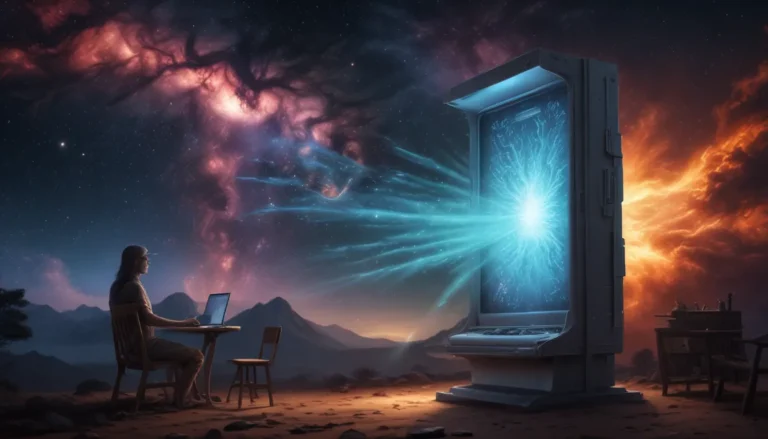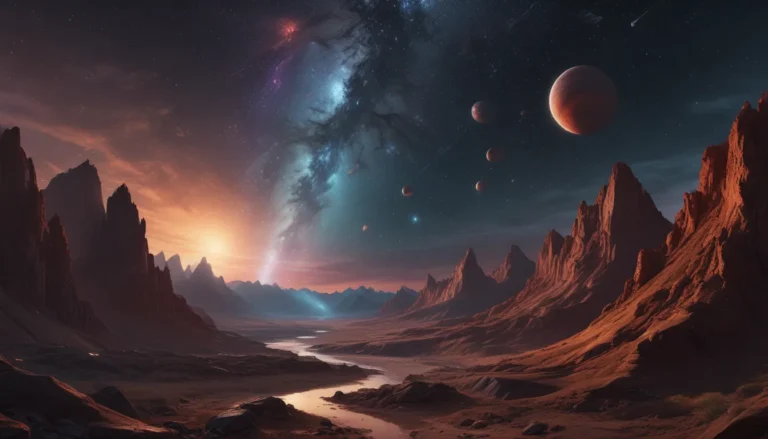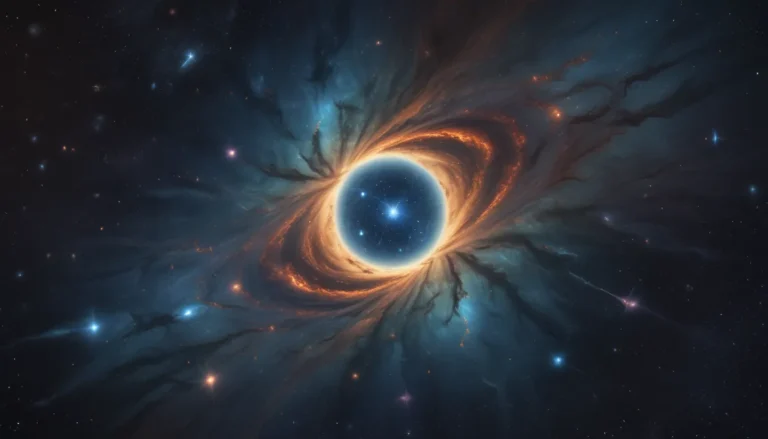The pictures we use in our articles might not show exactly what the words say. We choose these pictures to make you interested in reading more. The pictures work together with the words but don’t take their place. The words still tell you the important facts.
Have you ever gazed up at the night sky and wondered about the secrets hidden within our universe? Galactic archaeology offers a fascinating glimpse into the history and evolution of galaxies, shedding light on the cosmic mysteries that have captivated humanity for centuries. From ancient star clusters to the impact of supermassive black holes, this field of scientific research illuminates the complexities of our cosmic neighborhood.
In this exploration of galactic archaeology, we will embark on an enlightening journey through 20 astounding facts that showcase the incredible discoveries made by astronomers and astrophysicists. By delving into the formation and evolution of galaxies, tracing the origins of elements, and understanding the influence of dark matter, we will uncover the wonders of the cosmos like never before.
So, fasten your seatbelt, don your space helmet, and join us as we unravel the mysteries of galactic archaeology, one star at a time!
Unveiling the Secrets of Galactic Archaeology
Galactic archaeology is akin to peeling back the layers of history in a cosmic city, revealing the stories and secrets hidden within its structures and inhabitants. By studying stars, exoplanets, and ancient star clusters, scientists unlock the mysteries of galaxies, from their birth to their potential future. This captivating field merges astronomy, physics, and technology to push the boundaries of human knowledge, offering a unique window into the vast expanse of the universe.
Stars: The Enigmatic “Building Blocks” of Galactic Archaeology
Stars are not just twinkling specks in the night sky; they are the building blocks of galactic archaeology, providing invaluable clues about the formation and evolution of galaxies. By analyzing their composition, age, and distribution, scientists can unravel the intricate processes that have shaped these celestial bodies over billions of years. Each star bears a unique "fingerprint," a distinctive set of characteristics such as temperature, luminosity, and chemical composition, which aids in their identification and classification.
Stellar Populations: A Window into the Age of Galaxies
The mix of young and old stars within a galaxy serves as a timeline of its history. Galaxies dominated by youthful stars are considered "young," while those teeming with older stars are deemed "mature." By examining these stellar populations, scientists can estimate the age of a galaxy and gain insights into its evolution over cosmic time.
Galactic Mergers: Unraveling the Aftermath of Cosmic Collisions
Galactic mergers, the dramatic collisions of galaxies, are a common occurrence in the universe. Through galactic archaeology, scientists can study the aftermath of these mergers, offering clues to the formation of larger galaxies and the redistribution of star populations. These cosmic interactions provide a window into the dynamic and ever-changing nature of the universe.
Milky Way: Our Galactic Home Under the Cosmic Lens
As denizens of the Milky Way galaxy, we have a front-row seat to observe our cosmic neighborhood up close. Galactic archaeology enables us to study the history and structure of our own galaxy, shedding light on its past and its place amidst the vast tapestry of the universe. By delving into the mysteries of the Milky Way, we gain a deeper understanding of our celestial home and its cosmic connections.
Stellar Streams: Echoes of Galactic Encounters
Stellar streams are relics of smaller galaxies or star clusters that have been torn apart by larger galaxies through tidal forces. These streams serve as cosmic breadcrumbs, offering insights into past interactions and accretion events in a galaxy's history. By studying these stellar remnants, galactic archaeologists piece together the intricate dance of galaxies throughout the cosmos.
Tracing the Origin of Elements Through Galactic Archaeology
Stars serve as cosmic forges, synthesizing heavier elements through nuclear fusion. By analyzing the abundance of elements within stars, scientists can trace their origins and unravel the chemical evolution of galaxies. This glimpse into the elemental composition of stars provides a window into the cosmic alchemy that has shaped our universe.
Ancient Stars: Time Capsules of the Early Universe
Some stars, known as Population III stars, are believed to have formed shortly after the Big Bang. These ancient stellar remnants offer invaluable insights into the early stages of cosmic evolution, providing clues to the conditions of the nascent universe. By studying these celestial time capsules, galactic archaeologists peer into the dawn of cosmic history.
Exoplanets: Exploring Cosmic Habitability Through Galactic Archaeology
The discovery of exoplanets orbiting stars in distant galaxies offers a window into the structure, formation, and potential habitability of alien worlds. Galactic archaeology enhances our understanding of these exoplanetary systems, shedding light on the diverse landscapes and environments that populate our cosmic neighborhood. By studying these distant planets, scientists unlock the mysteries of galactic ecosystems beyond our own.
Dark Matter: Illuminating the Shadows of the Universe
Dark matter, an enigmatic substance that pervades the cosmos, remains a fundamental mystery in astrophysics. Through studying the kinematics of stars and their interactions with dark matter, galactic archaeologists contribute to our understanding of this elusive cosmic ingredient. By unraveling the role of dark matter in galaxy formation and evolution, scientists shed light on the invisible forces that shape the universe.
Supermassive Black Holes: Cosmic Titans of Galactic Evolution
At the heart of many galaxies lie supermassive black holes, gravitational giants that influence the structure and dynamics of their cosmic domains. By studying the effects of these cosmic behemoths through galactic archaeology, scientists untangle the intricate relationship between black holes and galaxies. These cosmic titans offer insights into the co-evolution of galaxies and supermassive black holes, illuminating the cosmic ballet that shapes our universe.
Cutting-Edge Technology: The Tools of Galactic Archaeology
From state-of-the-art telescopes and spectrographs to high-performance computing, galactic archaeologists harness cutting-edge technology to collect, analyze, and interpret vast amounts of data. These tools enable scientists to peer into the depths of the cosmos, unveiling hidden secrets and revealing the mysteries of galaxies. By leveraging innovative technology, galactic archaeologists push the boundaries of human knowledge and pave the way for new cosmic discoveries.
Gaia Mission: Mapping the Cosmic Tapestry
The European Space Agency's Gaia mission has revolutionized galactic archaeology by mapping the positions and properties of over a billion stars in the Milky Way. This unprecedented dataset offers a wealth of information for scientists, enabling them to unravel the complexities of our galaxy and its stellar inhabitants. The Gaia mission stands as a testament to human ingenuity and curiosity, opening new horizons in our exploration of the cosmos.
Globular Clusters: Ancient Beacons in the Cosmic Darkness
Globular clusters are dense collections of ancient stars that orbit galaxies like satellites. By studying the properties and distribution of these stellar ensembles, galactic archaeologists gain insights into the formation and evolution of galaxies. These ancient beacons serve as cosmic time capsules, preserving the history of galaxies within their twinkling confines.
Cosmic Web Structures: Unraveling the Tapestry of the Universe
Studying galaxies and their distribution offers a window into the intricate cosmic web, a vast network of interconnecting galaxies and cosmic structures. Galactic archaeology enables us to comprehend the complex relationships that weave through the cosmos, shedding light on the cosmic tapestry that forms the backbone of the universe. By unraveling the threads of the cosmic web, scientists gain a deeper understanding of the interconnectedness of cosmic structures.
Bridging Disciplines: The Fusion of Scientific Expertise
Galactic archaeology serves as a bridge between diverse fields of study, bringing together experts from astronomy, physics, chemistry, and computer science. Through interdisciplinary collaboration, scientists unravel the mysteries of galaxies, pooling their expertise to push the boundaries of human knowledge. By fostering collaboration and innovation, galactic archaeology showcases the power of diverse perspectives in unraveling the cosmic puzzle.
Citizen Science: Engaging Minds in Galactic Exploration
Citizen science projects, such as Galaxy Zoo, engage volunteers worldwide in classifying galaxies and analyzing data. These collaborative efforts harness the collective power of amateur astronomers and enthusiasts, contributing valuable insights to the field of galactic archaeology. By involving the public in scientific discovery, galactic archaeology fosters a sense of wonder and curiosity that transcends traditional boundaries, inspiring a new generation of cosmic explorers.
Pushing the Boundaries of Knowledge: The Quest for Cosmic Truth
Galactic archaeology stands at the forefront of scientific discovery, pushing the boundaries of human knowledge and unraveling the secrets of the universe. By delving into the history and composition of galaxies, scientists expand our understanding of the cosmos, offering new insights into the forces that shape the universe. Each discovery, each revelation, propels us further along the path of cosmic exploration, inviting us to gaze at the stars with wonder and curiosity.
Unveiling the Mysteries of Galactic Archaeology: A Cosmic Odyssey
Galactic archaeology offers a thrilling journey through the wonders of the cosmos, revealing the intricate tapestry of galaxies, stars, and cosmic structures that populate our universe. By exploring the history and evolution of galaxies, tracing the origins of elements, and understanding the dynamics of cosmic interactions, we gain a deeper appreciation for the beauty and complexity of the cosmos. Through cutting-edge technology, interdisciplinary collaboration, and citizen science, galactic archaeology propels us into a new era of cosmic exploration, where each discovery brings us closer to unraveling the mysteries of the universe.
As we gaze up at the night sky, let us remember that the stars above are not just distant specks of light but cosmic messengers, carrying with them the stories and secrets of the universe. Galactic archaeology invites us to embark on a voyage of discovery, to explore the depths of our galaxy and beyond, and to marvel at the wonders that await us in the cosmic expanse.
So, dear reader, which cosmic adventure will you choose next? Will you delve into the secrets of galactic dynamics, trace the origins of ancient stars, or unlock the mysteries of dark matter? The cosmos beckons, inviting you to join the quest for cosmic truth and embark on a journey through the depths of galactic archaeology. Let the stars guide you as you navigate the cosmic seas, for the universe holds boundless wonders just waiting to be discovered.
Conclusion: A Cosmic Tapestry of Discovery
In conclusion, galactic archaeology stands as a beacon of discovery, illuminating the mysteries of the cosmos and unraveling the secrets of galaxies. By studying the history, composition, and dynamics of the universe, scientists push the boundaries of human knowledge, offering new insights into the forces that shape the cosmic environment. From ancient star clusters to the impact of supermassive black holes, each facet of galactic archaeology reveals a new chapter in the cosmic saga, inviting us to explore the wonders of the universe with curiosity and awe.
As we reflect on the breathtaking discoveries of galactic archaeology, let us remember that the universe is a vast and wondrous tapestry, woven with threads of stars, galaxies, and cosmic structures. By delving into the mysteries of the cosmos, we embark on a journey of exploration and discovery, uncovering the untold stories hidden within the cosmic expanse. Galactic archaeology invites us to gaze at the stars with wonder and curiosity, inspiring us to embrace the limitless possibilities that await us in the cosmic sea.
FAQs: Unveiling the Mysteries of Galactic Archaeology
Q: What is galactic archaeology?
A: Galactic archaeology is a scientific discipline that focuses on studying the history and formation of galaxies, including our own Milky Way. It involves analyzing the properties and characteristics of stars, gas clouds, and other celestial objects to understand how galaxies evolve over time.
Q: How do scientists study galactic archaeology?
A: Scientists study galactic archaeology by using a combination of ground-based telescopes, space telescopes, and advanced computer simulations. They collect data on star clusters, stellar populations, chemical compositions, and galactic structures to unravel the mysteries of galaxies.
Q: What can we learn from galactic archaeology?
A: Galactic archaeology helps us understand the formation of galaxies, the distribution and movement of stars, the role of dark matter in galaxy evolution, and the origins of elements in the universe. It provides insights into the processes that shape and influence the cosmic environment.
Q: Why is galactic archaeology important?
A: Galactic archaeology plays a crucial role in advancing our understanding of the universe. By studying the history and properties of galaxies, we gain insights into the mechanisms driving their formation, the interactions between galaxies, and the dynamics of the cosmos as a whole.
Q: What are some notable discoveries in galactic archaeology?
A: Some notable discoveries in galactic archaeology include the identification of the oldest known star in the Milky Way, the discovery of ancient galaxies that formed shortly after the Big Bang, and the mapping of the distribution of dark matter in galaxies.
Q: How does galactic archaeology contribute to our knowledge of the universe?
A: Galactic archaeology contributes to our knowledge of the universe by unraveling the complex interplay between matter, energy, and dark matter. It provides valuable insights into the processes that have shaped galaxies over billions of years and helps us piece together the cosmic puzzle.
As you journey through the cosmos of galactic archaeology, may you be inspired by the wonders that await you and the mysteries that beg to be unraveled. The universe is a vast and boundless tapestry, waiting to be explored and understood. Join us in this cosmic odyssey, where each discovery brings us closer to the heart of the cosmic enigma. Let the stars guide you as you navigate the depths of space, for the universe is a place of endless fascination and discovery.
Was this page helpful?
Our commitment to delivering trustworthy and engaging content is at the heart of what we do. Each fact on our site is contributed by real users like you, bringing a wealth of diverse insights and information. To ensure the highest standards of accuracy and reliability, our dedicated editors meticulously review each submission. This process guarantees that the facts we share are not only fascinating but also credible. Trust in our commitment to quality and authenticity as you explore and learn with us.
As you delve deeper into the wonders of galactic archaeology, may you find inspiration and curiosity in the cosmic mysteries that surround us. Happy exploring!






